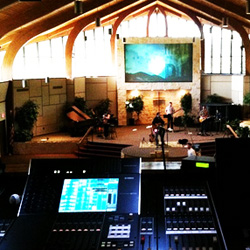
Line Array Loudspeakers
One improvement is to remove the stereo pair of point-source loudspeakers and install a floor-to-ceiling line array located in the center of the back wall as shown in Figure 13 (below).
Coverage of the congregation is more even, and the level at the FOH mixer location is very similar to the coverage level over the whole floor of the congregation.
The level of the stage monitors is greatly reduced and some of the stage monitors may no longer be needed depending on the individual needs of the musicians.
Within the near field of the line array there is a range were the audio level will decrease by only 3 dB for each doubling of distance which greatly helps even the coverage across the entire floor.
One other characteristic of this application is that the audio is distributed across the whole line so that even if a microphone is right next to the line there is little tendency to feedback.
In this example, there is a low suspended-acoustic-tile ceiling that shortens the length of a line array speaker. This limits some of the good qualities of a line array, so it might not be the best solution.
If the room were remodeled so there was a high ceiling, then a line array would make more sense because a longer line array would fit.
This is especially true if the newly remodeled ceiling was acoustically reflective causing the RT60 of the room to be much greater.
The high directivity of a long line array greatly helps to project the audio out to the floor rather then have the audio directed toward the ceiling where it contributes to the reverberant energy and slap echoes in the room.
Supplemental Distributed Array Loudspeakers
Because of the dropped ceiling, another option would be a distributed array of supplemental ceiling loudspeakers in the back of the room as shown in Figure 14. The loudness level of the main stereo pair could be reduced by at least 12 dB.
This would greatly diminish the effects of the hot spots in the front of the room but would leave the level at the back of the room way too low. Ceiling loudspeakers can be added in the locations shown to fill in the audio in the back of the room.
It would be very important to include a speaker over the mixer location so the audio at that location matches the level in the congregation to aid in achieving an accurate mix.
Why The Delay?
The ceiling loudspeaker signals should be delayed in time, so their output combines coherently with the output from the point-source pair in the front of the room.
If the rear loudspeakers are not correctly delayed then the loudspeakers in the room will not combine correctly.
This room is too small for audio from the front of the room to be perceived as a distinct echo.
Applying a proper delay to the ceiling loudspeakers can minimize the problem of localization confusion that occurs if the first arrival sound is coming from the overhead loudspeakers and not the front of the room.


